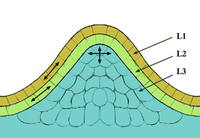
Photo from wikipedia
The development of tree architecture results from shoot growth and branching, but their relationship is still not fully understood. The goal of this study was to determine the effect of… Click to show full abstract
The development of tree architecture results from shoot growth and branching, but their relationship is still not fully understood. The goal of this study was to determine the effect of parent shoot growth characteristics on branching patterns in terms of polycyclism, growth duration (GD), and growth period (GP), considering apple tree as a case study. Weekly shoot growth records were collected from 227 shoots during their second year of growth and the resulting branching patterns from the following year. The branching patterns were compared between the different shoot categories, using hidden semi-Markov models. Our results showed that the branching pattern was similar in bicyclic and monocyclic shoots with a long GD. The number of floral laterals, and the frequency and length of the floral zones, increased with GD. Moreover, a long GD led to strong acrotony, due to the high occurrence of a vegetative zone with long laterals in the distal position of the shoot. In bicyclic shoots, an early GP of the second GU led to more frequent and longer floral zones than a late GP. Therefore, the GD was the strongest driver of the branching pattern, and GP modulated the flowering capacity. The main similarities among shoot categories resulted from the existence of latent buds and floral zones associated with growth cessation periods. Even though flowering was more abundant during the early GP, the positions of floral zones indicated that induction in axillary meristems can also occur late in the season. This study provides new knowledge regarding the relationships between the dynamics of parent shoot growth and axillary meristem fates, with key consequences on flowering abundance and positions.
Journal Title: Frontiers in Plant Science
Year Published: 2020
Link to full text (if available)
Share on Social Media: Sign Up to like & get
recommendations!